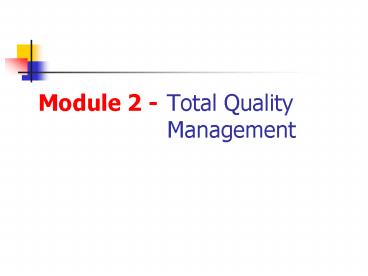Module 2 Total Quality Management PowerPoint PPT Presentation
1 / 26
Title: Module 2 Total Quality Management
1
Module 2 - Total Quality Management
2
Course Framework
- 1. Cost
- - Design Selection
- 2. Quality
- - TQM
- - SQC
- 3. Speed
- - Project Management
- - Supply Chain
- 4. Flexibility
- - Supply Chain
- - Inventory
- - Location
- - Forecasting
- - Aggregate Planning
3
Learning Objectives
- Explain the meaning of TQM
- Identify ways of improving quality
- Identify tools used for solving quality problems
- Understand why TQM projects fail
4
What is TQM?
- Meeting quality expectations as defined by the
customer - Integrated organizational effort designed to
improve quality of processes at every business
level
5
TQM Philosophy Whats Different?
- Focus on Customer
- Identify and meet customer needs
- Continuous Improvement
- Continuous learning and problem solving
- Quality at the Source
- Inspection vs. prevention problem solving
- Employee Empowerment
- Empower employees and customers
6
TQM Philosophy (continued)
- Understanding Quality Tools
- Ongoing training on analysis, assessment, and
correction, implementation tools - Team Approach
- Teams formed around processes 8 to 10 people
- Meet weekly to analyze and solve problems
- Benchmarking
- Studying practices at best in class companies
7
Dimensions of Quality
- Quality of design
- Features to include in the final design
- Quality of conformance to design
- Production processes to meet design
specifications - Ease of use
- Instructions, operation, maintenance, safety
- Post-sale service
- Responsiveness, rapid repair, p.m., spare parts
8
Quality Gurus
- W. Edwards Deming
- Phillip Crosby
- Joseph M. Juran
9
Deming Natural variability
- All process are subject to variability
- Natural causes
- Assignable causes
- Objective Identify assignable causes
10
Crosby Importance of Quality
11
Juran Cost of Quality
- Prevention costs
- Preparing implementing a quality plan
- Appraisal costs
- Testing, evaluating inspecting quality
- Internal failure costs
- Defects incurred within system
- External failure costs
- Defects that escape system
12
COQ Relationship
13
Ways of Improving Quality
- Plan-Do-Study-Act Cycle (PDSA)
- Also called the Deming Wheel after originator
- Circular, never ending problem solving process
- Quality Function Deployment
- Used to translate customer preferences to design
- Seven Tools of Quality Control
- Tools typically taught to problem solving teams
14
PDSA Details
- Plan
- Evaluate current process
- Collect procedures, data, identify problems
- Develop an improvement plan, performance
objectives - Do
- Implement the plan trial basis
- Study
- Collect data and evaluate against objectives
- Act
- Communicate the results from trial
- If successful, implement new process
15
PDSA (continued)
- Cycle is repeated
- After act phase, start planning and repeat process
16
QFD Details
- Process used to ensure that the product meets
customer specifications
Voice of the engineer
Customer-based benchmarks
Voice of the customer
17
QFD - House of Quality
- Adding trade-offs, targets developing product
specifications
Trade-offs
Technical Benchmarks
Targets
18
Seven Problem Solving Tools
- Flowcharts
- Checklists
- Scatter Diagrams
- Cause-and-Effect Diagrams
- Histograms
- Pareto Analysis
- Control Charts
19
Flowcharts
- Used to document the detailed steps in a process
- Often the first step in operations analysis
20
Checklist
- Simple data check-off sheet designed to identify
type of quality problems at each work station
per shift, per machine, per operator
21
Scatter Diagrams
- A graph that shows how two variables are related
to one another - Data can be used in a regression analysis to
establish equation for the relationship
22
Cause-and-Effect Diagrams
- Called Fishbone Diagram
- Focused on solving identified quality problem
23
Histograms
- A chart that shows the frequency distribution of
observed values of a variable like service time
at a bank drive-up window
24
Pareto Analysis
- Technique that displays the degree of importance
for each element - Quality problems are the result of only a few
problems e.g. 80 of the problems caused by 20
of causes
25
Control Charts
- Important tool used in Statistical Process
Control - The UCL and LCL are calculated limits used to
show when process is in or out of control
26
Why TQM Efforts Fail
- Lack of a genuine quality culture
- Lack of top management support and commitment
- Over- and under-reliance on SPC methods

